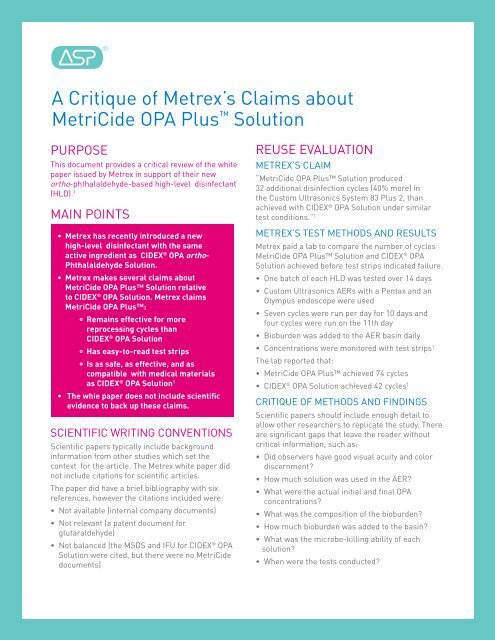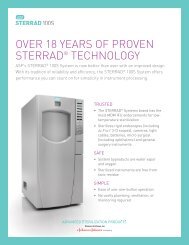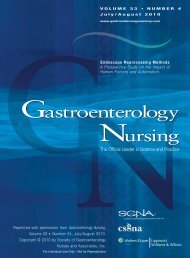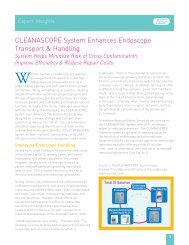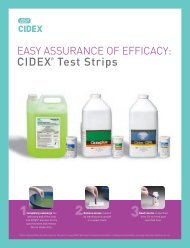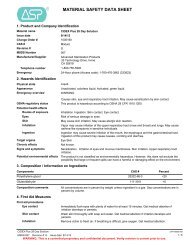A Critique of Metrex's Claims about MetriCide OPA Plus™ Solution
A Critique of Metrex's Claims about MetriCide OPA Plus™ Solution
A Critique of Metrex's Claims about MetriCide OPA Plus™ Solution
Create successful ePaper yourself
Turn your PDF publications into a flip-book with our unique Google optimized e-Paper software.
A <strong>Critique</strong> <strong>of</strong> Metrex’s <strong>Claims</strong> <strong>about</strong><br />
<strong>MetriCide</strong> <strong>OPA</strong> Plus <strong>Solution</strong><br />
PuRPOSe<br />
this document provides a critical review <strong>of</strong> the white<br />
paper issued by Metrex in support <strong>of</strong> their new<br />
ortho-phthalaldehyde-based high-level disinfectant<br />
(hlD). 1<br />
MAin POintS<br />
• Metrex has recently introduced a new<br />
high-level disinfectant with the same<br />
active ingredient as CIDEX ® <strong>OPA</strong> ortho-<br />
Phthalaldehyde <strong>Solution</strong>.<br />
• Metrex makes several claims <strong>about</strong><br />
<strong>MetriCide</strong> <strong>OPA</strong> Plus <strong>Solution</strong> relative<br />
to CIDEX ® <strong>OPA</strong> <strong>Solution</strong>. Metrex claims<br />
<strong>MetriCide</strong> <strong>OPA</strong> Plus:<br />
° Remains effective for more<br />
reprocessing cycles than<br />
CIDEX ® <strong>OPA</strong> <strong>Solution</strong><br />
° Has easy-to-read test strips<br />
° Is as safe, as effective, and as<br />
compatible with medical materials<br />
as CIDEX ® <strong>OPA</strong> <strong>Solution</strong>1 • The whie paper does not include scientific<br />
evidence to back up these claims.<br />
SCientifiC WRiting COnventiOnS<br />
Scientific papers typically include background<br />
information from other studies which set the<br />
context for the article. the Metrex white paper did<br />
not include citations for scientific articles.<br />
the paper did have a brief bibliography with six<br />
references, however the citations included were:<br />
• not available (internal company documents)<br />
• not relevant (a patent document for<br />
glutaraldehyde)<br />
• not balanced (the MSDS and ifu for CiDex ® <strong>OPA</strong><br />
<strong>Solution</strong> were cited, but there were no <strong>MetriCide</strong><br />
documents)<br />
ReuSe evAluAtiOn<br />
MetRex’S ClAiM<br />
“<strong>MetriCide</strong> <strong>OPA</strong> Plus <strong>Solution</strong> produced<br />
32 additional disinfection cycles (40% more) in<br />
the Custom ultrasonics System 83 Plus 2, than<br />
achieved with CiDex ® <strong>OPA</strong> <strong>Solution</strong> under similar<br />
test conditions.” 1<br />
MetRex’S teSt MethODS AnD ReSultS<br />
Metrex paid a lab to compare the number <strong>of</strong> cycles<br />
<strong>MetriCide</strong> <strong>OPA</strong> Plus <strong>Solution</strong> and CiDex ® <strong>OPA</strong><br />
<strong>Solution</strong> achieved before test strips indicated failure.<br />
• One batch <strong>of</strong> each hlD was tested over 14 days<br />
• Custom ultrasonics AeRs with a Pentax and an<br />
Olympus endoscope were used<br />
• Seven cycles were run per day for 10 days and<br />
four cycles were run on the 11th day<br />
• Bioburden was added to the AeR basin daily<br />
• Concentrations were monitored with test strips1 the lab reported that:<br />
• <strong>MetriCide</strong> <strong>OPA</strong> Plus achieved 74 cycles<br />
• CiDex ® <strong>OPA</strong> <strong>Solution</strong> achieved 42 cycles1 CRitique Of MethODS AnD finDingS<br />
Scientific papers should include enough detail to<br />
allow other researchers to replicate the study. there<br />
are significant gaps that leave the reader without<br />
critical information, such as:<br />
• Did observers have good visual acuity and color<br />
discernment?<br />
• how much solution was used in the AeR?<br />
• What were the actual initial and final <strong>OPA</strong><br />
concentrations?<br />
• What was the composition <strong>of</strong> the bioburden?<br />
• how much bioburden was added to the basin?<br />
• What was the microbe-killing ability <strong>of</strong> each<br />
solution?<br />
• When were the tests conducted?
Several aspects <strong>of</strong> the Metrex test procedure were<br />
scientifically flawed:<br />
• <strong>Solution</strong> expiration dates were vastly different:<br />
° CiDex ®<br />
<strong>OPA</strong> ortho-phthalaldehyde <strong>Solution</strong>:<br />
november 2008<br />
° <strong>MetriCide</strong> <strong>OPA</strong> Plus : August 20091 • test strip expiration dates were very different:<br />
° CiDex ®<br />
<strong>OPA</strong> <strong>Solution</strong>: february 2008<br />
° <strong>MetriCide</strong> <strong>OPA</strong> Plus : August 20081 • Since only test strips were used to test the<br />
solution, 1 it is not clear whether there was truly<br />
a difference in concentration <strong>of</strong> the solution, or<br />
issues with the accuracy <strong>of</strong> the test strips.<br />
• Metrex chose to test each solution only once, 1 when<br />
replication <strong>of</strong> experiments is an essential part <strong>of</strong><br />
scientific inquiry.<br />
COntRASting MethODS AnD<br />
finDingS in CliniCAlly BASeD<br />
PuBliSheD liteRAtuRe<br />
in 2003, gastroenterology nursing published a study<br />
which tested CiDex ®<br />
<strong>OPA</strong> <strong>Solution</strong> at Massachusetts<br />
general hospital (Mgh). 2<br />
the methods <strong>of</strong> this study were more rigorous than<br />
the Metrex test, including:<br />
• Reprocessing 1,839 endoscopes in 1,201 cycles in a<br />
Custom ultrasonics AeR<br />
• Reprocessing clinically used endoscopes<br />
• testing solutions by:<br />
° test strips<br />
° Chemical tests <strong>of</strong> concentration<br />
° Antimicrobial efficacy 2<br />
in contrast to the Metrex findings, the Mgh study<br />
found that CiDex ®<br />
<strong>OPA</strong> <strong>Solution</strong>:<br />
• lasted the entire two-week reuse period<br />
• Reprocessed an average <strong>of</strong> 80 endoscopes per<br />
batch (with a maximum <strong>of</strong> 98 cycles) 2<br />
thus this larger, more rigorous clinical study does<br />
not substantiate Metrex’s test results.<br />
teSt StRiP evAluAtiOn<br />
MetRex’S ClAiMS<br />
“<strong>MetriCide</strong> <strong>OPA</strong> Plus <strong>Solution</strong> test Strips <strong>of</strong>fer<br />
significant advantages over that <strong>of</strong> the CiDex ®<br />
<strong>OPA</strong><br />
<strong>Solution</strong> test Strips. these advantages include:<br />
• 33% faster test results than the CiDex ®<br />
<strong>OPA</strong> test<br />
Strips.<br />
• easy interpretation <strong>of</strong> pass/fail results when<br />
compared to color blocks located on the <strong>MetriCide</strong><br />
<strong>OPA</strong> Plus <strong>Solution</strong> test Strip Bottle.<br />
• <strong>MetriCide</strong> <strong>OPA</strong> Plus <strong>Solution</strong> test Strips are more<br />
conveniently packaged in 100 test strips per<br />
bottle to enhance test strip availability.” 1<br />
MetRex’S teSt MethODS AnD<br />
finDingS<br />
the white paper does not describe any research<br />
process or findings that back up these claims.<br />
CRitique Of MethODS AnD finDingS<br />
• how was test strip speed assessed?<br />
• how was ease <strong>of</strong> interpretation assessed?<br />
• how does Metrex packaging enhance availability?<br />
uSe StABility teSting<br />
MetRex’S ClAiM<br />
Metrex claimed the ph, concentration, and<br />
appearance <strong>of</strong> their solution “remained relatively<br />
unchanged” over the 75-day test period. 1<br />
MetRex’S teSt MethODS AnD ReSultS<br />
use stability appears to have been tested by leaving<br />
three containers <strong>of</strong> <strong>MetriCide</strong> <strong>OPA</strong> Plus <strong>Solution</strong><br />
open for 75 days. During the test period, ph,<br />
concentration, and appearance were evaluated at<br />
Days 1, 30, and 75.<br />
Metrex reported the following results: 1<br />
Use Stability Test Results<br />
<strong>OPA</strong> lot % <strong>OPA</strong> (Day 1) % <strong>OPA</strong> (Day 75)<br />
A 0.64 0.67<br />
B 0.66 0.71<br />
C 0.63 0.65<br />
note: the increase in <strong>OPA</strong> concentration was<br />
attributed to water evaporation.
CRitique Of MethODS AnD finDingS<br />
• how was appearance evaluated?<br />
• how were ph and concentration tested?<br />
<strong>MetriCide</strong> <strong>OPA</strong> Plus <strong>Solution</strong>’s concentration was<br />
greater than the 0.60% advertised even at baseline.<br />
the increased concentration may partially explain the<br />
added number <strong>of</strong> cycles reported in reuse testing. 3<br />
the actual concentration <strong>of</strong> CiDex ®<br />
<strong>OPA</strong> ortho-<br />
phthalaldehyde <strong>Solution</strong> was not tested.<br />
SAfety teSting<br />
MetRex’S ClAiM<br />
“test results point out the equivalent safety <strong>of</strong> these<br />
products.” [<strong>MetriCide</strong> <strong>OPA</strong> Plus <strong>Solution</strong> and<br />
CiDex ®<br />
<strong>OPA</strong> <strong>Solution</strong>] 1<br />
MetRex’S teSt MethODS AnD ReSultS<br />
there are no descriptions or references for the safety<br />
test data for <strong>MetriCide</strong> <strong>OPA</strong> Plus <strong>Solution</strong>.<br />
CiDex ®<br />
<strong>OPA</strong> <strong>Solution</strong> test results were taken from the<br />
product Material Safety and Data Sheet.<br />
Metrex concluded the two high-level disinfectants were<br />
equivalent with respect to safety. 1 however, potential<br />
effects <strong>of</strong> using a higher initial concentration <strong>of</strong><br />
<strong>MetriCide</strong> <strong>OPA</strong> Plus <strong>Solution</strong> were not addressed.<br />
CRitique Of MethODS AnD finDingS<br />
there is no explanation <strong>of</strong> the methods or results for<br />
the tests presented, so evaluation <strong>of</strong> the conclusions is<br />
not possible.<br />
MiCROBiOlOgiCAl<br />
effiCACy teSting<br />
MetRex’S ClAiM<br />
<strong>MetriCide</strong> <strong>OPA</strong> Plus <strong>Solution</strong> is equivalent to<br />
CiDex ® <strong>OPA</strong> <strong>Solution</strong> in efficacy against microbes. 1<br />
MetRex’S teSt MethODS AnD ReSultS<br />
Aside from mentioning the tests were conducted in<br />
accordance with ePA standards (which were not cited),<br />
there is no further information <strong>about</strong> test methods. 1<br />
for microbes where both solutions were tested, the<br />
killing time results reported are equal. for example,<br />
both CiDex ®<br />
<strong>OPA</strong> <strong>Solution</strong> and <strong>MetriCide</strong> <strong>OPA</strong> Plus <strong>Solution</strong> reported to have killed hiv–1 in five minutes. 1<br />
CRitique Of MethODS AnD finDingS<br />
• how were the tests conducted?<br />
• Were the organisms tested laboratory or clinical<br />
strains?<br />
• Was the first evaluation <strong>of</strong> antimicrobial activity done<br />
at 5 minutes?<br />
• Was <strong>MetriCide</strong> <strong>OPA</strong> Plus <strong>Solution</strong> able to kill the<br />
microbes at shorter time frames?<br />
COntRASting MethODS AnD finDingS<br />
in PuBliSheD liteRAtuRe<br />
CiDex ®<br />
<strong>OPA</strong> <strong>Solution</strong> has been tested extensively by<br />
independent researchers around the world using a<br />
4, 5<br />
variety <strong>of</strong> methods.<br />
Japanese researchers tested CiDex ®<br />
<strong>OPA</strong> <strong>Solution</strong><br />
against 21 strains <strong>of</strong> disease-causing microbes. 4<br />
CiDex ®<br />
<strong>OPA</strong> <strong>Solution</strong> at 0.50% concentration was able<br />
to kill:<br />
• All vegetative bacteria within 15 seconds<br />
• All mycobacteria within one minute<br />
• All fungi within one minute<br />
Spanish researchers tested CiDex ®<br />
<strong>OPA</strong> <strong>Solution</strong><br />
against microbes that were freshly isolated from<br />
intensive care units patients under “worst case”<br />
conditions. 5 freshly isolated organisms may be more<br />
resistant to hlD killing action than the typically used<br />
laboratory strains which weaken over time.<br />
“The increased susceptibility <strong>of</strong> laboratoryadapted<br />
organisms may allow any disinfectant<br />
product to pass the standard tests but the<br />
product may fail in the clinical setting.” 5<br />
the “worst case” conditions included:<br />
• Contaminating rough-surfaced instruments (files<br />
used on teeth)<br />
• Allowing the contaminated files to dry<br />
the contaminated files were exposed to CiDex ®<br />
<strong>OPA</strong><br />
<strong>Solution</strong> for 10 minutes. 5<br />
the researchers conducted this experiment found<br />
CiDex ®<br />
<strong>OPA</strong> <strong>Solution</strong> was able to kill 77% <strong>of</strong> the<br />
organisms tested within 10 minutes. 5<br />
DiSCuSSiOn AnD COnCluSiOnS<br />
there are technical flaws in the <strong>MetriCide</strong> <strong>OPA</strong> Plus <br />
<strong>Solution</strong> white paper. these include:<br />
• not clearly stating the methods used to conduct<br />
tests.<br />
• not referencing the sources for data used from<br />
others’ work.<br />
• Drawing conclusions based on conjecture or<br />
opinion.<br />
• testing solutions with very different expiration dates.<br />
• not conducting confirmatory tests <strong>of</strong> concentration<br />
during the reuse study.<br />
• not including relevant references.<br />
given that the two hlDs do have the same active<br />
ingredient at very similar concentrations, it is<br />
reasonable to assume the properties are very similar.<br />
however, the increased efficiency claims do not seem<br />
to be well supported by what is presented in the<br />
white paper, nor what is available in the published<br />
literature.
RefeRenCeS<br />
1. Bruckner n. Comparison <strong>of</strong> <strong>MetriCide</strong> <strong>OPA</strong> Plus<br />
<strong>Solution</strong> and CiDex <strong>OPA</strong> <strong>Solution</strong> use Properties.<br />
Orange, CA: Metrex Research Corporation;<br />
October 2007.<br />
2. hession S. endoscope disinfection by orthophthalaldehyde<br />
in a clinical setting. gastroenterology<br />
nursing. 2003;26(3):110-114.<br />
3. Bruckner n, gordon M, howell R, Bruckner n, gordon M,<br />
howell R Bruckner n, gordon M, howell Rs.<br />
Odorless aromatic dialdehyde disinfecting and<br />
sterilizing composition and method <strong>of</strong> using the same.<br />
uS patent 4,971,999. May 1987.<br />
4. Akamatsu t, Minemoto M, uyeda M. evaluation <strong>of</strong><br />
the antimicrobial activity and materials compatibility <strong>of</strong><br />
ortho-phthalaldehyde as a high-level disinfectant.<br />
J int Med Res. March-April 2005;33(2):178-187.<br />
5. herruzo-Cabrera R, vizcaino-Alcaide MJ,<br />
fernandez-Acenero MJ. the influence <strong>of</strong> laboratory<br />
adaptation on test strains, such as Pseudomonas<br />
aeruginosa, in the evaluation <strong>of</strong> the antimicrobial<br />
efficacy <strong>of</strong> ortho-phthalaldehyde. J hosp infect.<br />
July 2004;57(3):217-222.<br />
<strong>MetriCide</strong> <strong>OPA</strong> Plus is a registered trademark <strong>of</strong> Metrex Corporation.<br />
Olympus is a registered trademark <strong>of</strong> Olympus Corporation.<br />
Pentax is a registered trademark <strong>of</strong> Pentax Medical Company.<br />
© ethicon, inc. 2011<br />
AD-080005-01-uS_B


